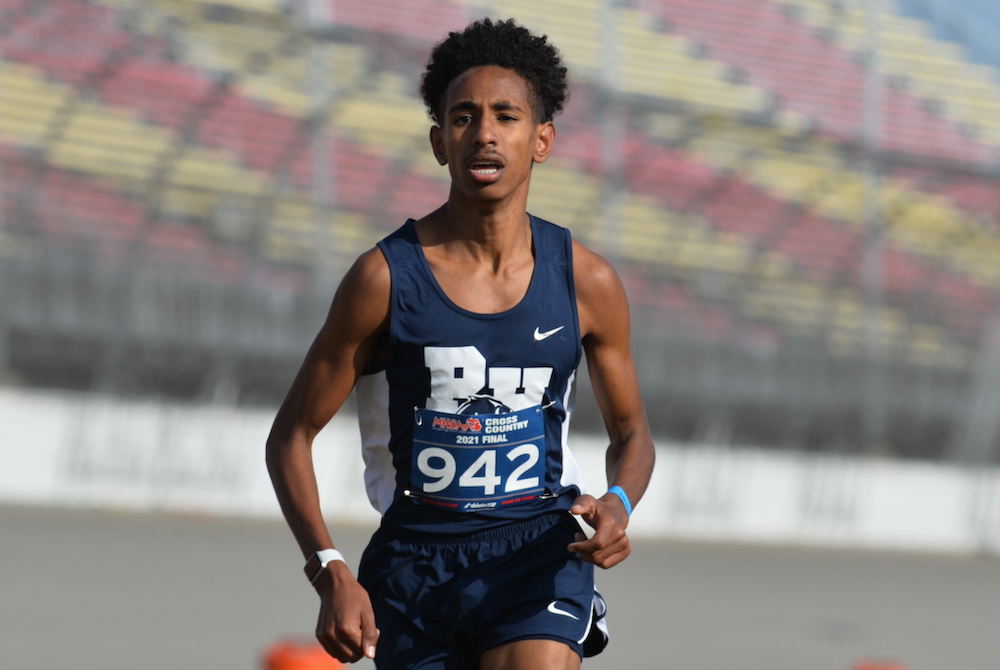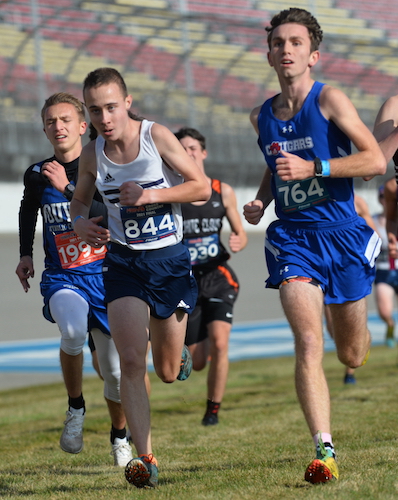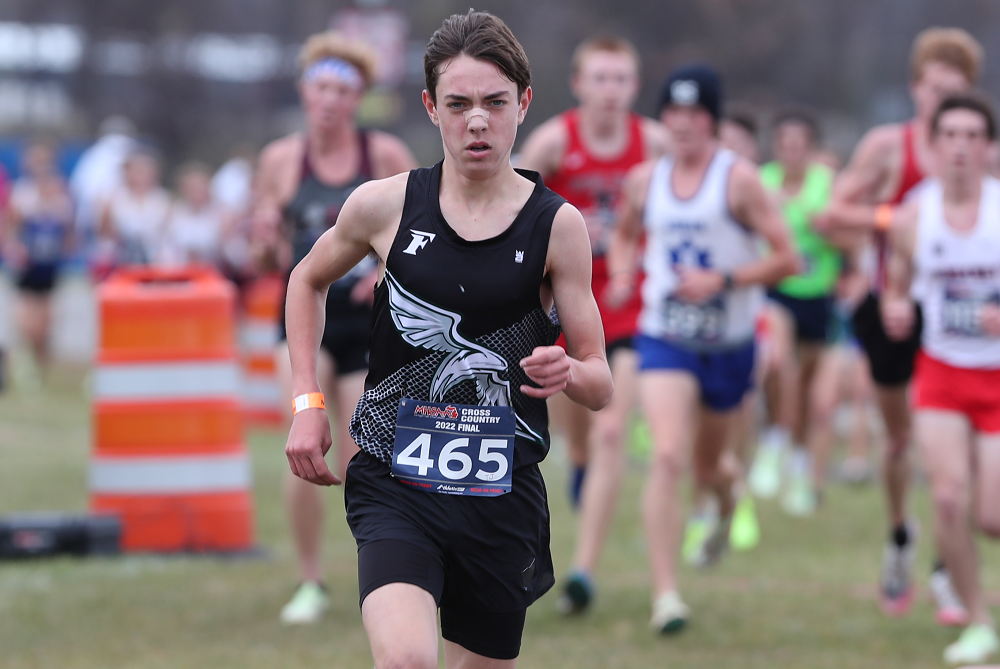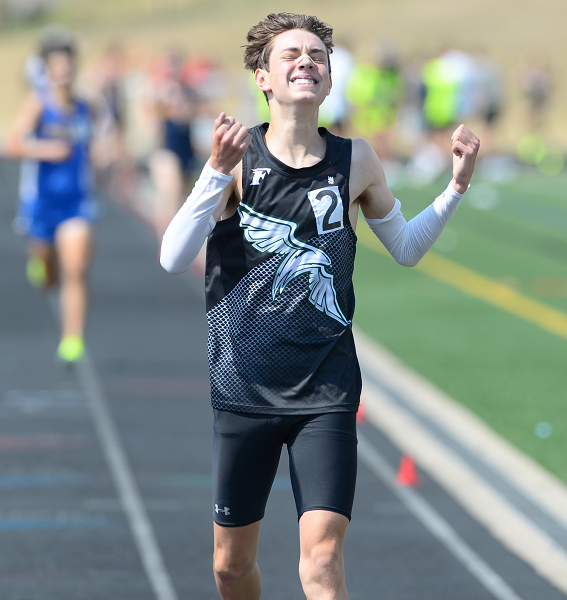
Potter's House's Osterink, Hillsdale Academy Earn 1st Finals Wins
November 6, 2021
BROOKLYN — Lezawe Osterink’s arrival among the state’s elite was deferred for a year.
He was ready to make a run at the MHSAA Lower Peninsula Division 4 cross country championship in 2020, but was unable to run at Regionals after breaking his collarbone on a training run.
Who says cross country isn’t a contact sport?
The junior from Wyoming Potter’s House showed up Saturday at Michigan International Speedway as a different runner than the one who had a respectable 55th place as a freshman in 2019.
Osterink completed an undefeated season by winning the Division 4 race in 15:50.60. He won by 23.76 seconds ahead of Concord senior Jonathan Mikovits.
Last year, Osterink was on track to get to MIS when he won the Pre-Regional meet.
“I broke my collarbone before Regionals, then I got COVID,” he said. “That was kind of a big disappointment. I couldn’t run at all. We were going to try to push it and try to win state that year.”
 Osterink won all 13 races in which he competed this fall, giving him a 14-race winning streak going back to last season.
Osterink won all 13 races in which he competed this fall, giving him a 14-race winning streak going back to last season.
After racing at MIS as a freshman, he began to dream about becoming a Finals champion.
“I didn’t know if it would become realistic,” Osterink said. “I put in a lot of work. Our coach knows what he’s doing. I had good teammates to train with. That’s what I would say got me here.”
Osterink reached the mile mark in 5:03.3, giving him a 4.6-second cushion over Mikovits. The lead increased to 7.6 seconds when Osterink hit a two-mile split of 10:10.1.
“I could feel myself running away,” he said. “I was surprised. They went out good. They stuck with me for a while. I was scared of the guy behind me. I didn’t look back, but people who were there said he was close, so I had to keep hammering the whole time.”
In the team competition, Hillsdale Academy grouped its second through fifth runners only 13 seconds apart to win with a score of 154 points.
Senior Emil Schlueter gave Hillsdale Academy a low stick with his eighth-place finish in 16:49.75, good for sixth among team runners. Two eighth-graders scored for the Colts: Cole Bates (64th, 17:56.70) and Grayson Rorick (72nd, 18:02.22). Also scoring were sophomore Thomas Holm (51st, 17:49.17) and freshman Vincent Reagle (69th, 17:59.71).
It was the first MHSAA team championship for the Colts, whose best finishes were 10th-place showings in 2010 and 2018.
Concord had three runners in the top 22, but had to count runners who were 75th and 159th overall.
PHOTOS Potter’s House’s Lezawe Osterink approaches the finish of the Division 4 Final at Michigan International Speedway. (Middle) Hillsdale Academy’s Thomas Holm (844) and Adrian Lenawee Christian’s Grant Long (764) push down the final stretch. (Click for more from RunMichigan.com.)

Freeland's Hansen Not Focused on Joining All-Time Greats - But On His Way
By
Paul Costanzo
Special for MHSAA.com
September 29, 2023
The goal written on Matt Kaczor’s Post-It Note was sub-15 minutes, 15 seconds. That’s what the Freeland cross country coach was hoping for from star runner TJ Hansen during his junior season.
 Kaczor tore it up after seeing Hansen run a single race this fall.
Kaczor tore it up after seeing Hansen run a single race this fall.
“Knowing what he did over the summer and where he was at, seeing what his 1,600 (meter) and his mile got down to, I had a feeling he could get under 15:30 quickly,” Kaczor said. “After the first race, I looked at my assistant and was like, ‘I’ve gotta rip up that Post-It Note. I don’t think our goal is on the level of where he’s at right now.’ At first, it was break 15:15. Once I saw him race at the Under the Lights (on Aug. 18 at St. Johns), I was like, ‘Yeah, he’s going sub 15.’”
Hansen ran 15:39.6 in that first race, and on Sept. 7, in Shepherd, he ran 15:13.9 to meet the goal written on the now-shredded Post-It Note.
This past Saturday, he ran 15:03.7 at the Cadillac Veterans Serving Veterans Invitational. It’s the fastest time recorded in Michigan this year, and a signal that Kaczor might be filling out a new Post-It Note before the season is out.
“The sub-15 barrier, that’s been something on my mind for a while,” Hansen said. “Now that I’m edging closer and closer to that, it’s been exciting. With how heavy my training has been, I wouldn’t expect (to have run this fast this early). Being able to run the times I am really paints the picture for what’s ahead.”
Hansen came into the season already regarded as one of the elite distance runners in the state. He won the 3,200 meters at the MHSAA Lower Peninsula Division 2 Track & Field Finals this past spring. He’s also finished all-state (12th and fifth, respectively) the past two seasons at the LPD2 Cross Country Finals.
His current trajectory, however, would put his name near some of the state’s all-time greats. But that’s not something Hansen is focusing on.
“I really don’t like to compare myself to others,” he said. “I don’t focus on that. I try to be the best TJ Hansen that I can be. The best version of myself.”
Focusing on himself is almost necessary for Hansen, as he’s spending a lot of time during his races running by himself.
At each of the big events Freeland has run in this season, Hansen has finished at least 20 seconds ahead of his nearest competitor. That includes all divisions of the Duane Raffin Festival of Races in Holly.
In Cadillac, where Hansen ran his current best time, he was a full minute ahead of the rest of the field.
 “He’s just a special athlete,” Kaczor said. “I can’t see Freeland having someone like this in a while. He’s a generational talent. What’s crazy is, I had the school record when he was a freshman. He and Braden (Honsinger) broke it last year. But TJ has now dropped that school record (set in 1998) by almost a minute.”
“He’s just a special athlete,” Kaczor said. “I can’t see Freeland having someone like this in a while. He’s a generational talent. What’s crazy is, I had the school record when he was a freshman. He and Braden (Honsinger) broke it last year. But TJ has now dropped that school record (set in 1998) by almost a minute.”
Hansen’s achievements have already put him on a path to run at the next level, which is something of a family tradition.
His older sisters Peyton and Kiera are track & field athletes at Wayne State and Eastern Michigan, respectively. Their parents, Tim and Pam, were track & field stars at Central Michigan.
TJ has drawn the attention of coaches around the country, including from Michigan, Michigan State, Wisconsin, Tennessee and Colorado.
Having family members who know the process is a help for Hansen, and he said they’ve all been good about allowing him to choose his own path, whatever that may be.
“He’s from a good family that knows how to work and knows how to get things done,” Kaczor said. “He knows that if he puts in the work, he’s going to be at a good spot.”
While Hansen admits it can be a bit overwhelming, he’s using it as motivation to run faster and continue to put his name out there.
Also serving as motivation is 2022 Division 2 champion Connell Alford of Chelsea. Alford is among the elite group of runners in Michigan who have broken the 15-minute mark, doing it twice a year ago.
He currently has the state’s second-best time behind Hansen’s this year, running 15:09.1 at the MSU Invitational on Sept. 15.
“Whenever I see him drop a time, my main goal is to run faster,” Hansen said. “Whenever I see him run a good time, that motivates me to work hard.”
The two won’t see each other until the MHSAA Finals on Nov. 4 at Michigan International Speedway. It’s an opportunity Hansen is excited for, as it’s a chance to race and be pushed toward the lofty goals he’s set for himself. Kaczor is excited about it, too, even if it might mean having to replenish his supply of Post-Its.
“We don’t talk about winning the state title; we talk about making sure that we have great races on those days,” Kaczor said. “We can’t control how somebody else runs. It’s a matter of can we, if the weather is right and the course is in good condition, can we be one of the few guys that has run in the 14s on that course? That’s the goal. Put yourself in some great categories with those upper echelons and the greats of all-time.”
 Paul Costanzo served as a sportswriter at The Port Huron Times Herald from 2006-15, including three years as lead sportswriter, and prior to that as sports editor at the Hillsdale Daily News from 2005-06. He can be reached at [email protected] with story ideas for Genesee, Lapeer, St. Clair, Sanilac, Huron, Tuscola, Saginaw, Bay, Arenac, Midland and Gladwin counties.
Paul Costanzo served as a sportswriter at The Port Huron Times Herald from 2006-15, including three years as lead sportswriter, and prior to that as sports editor at the Hillsdale Daily News from 2005-06. He can be reached at [email protected] with story ideas for Genesee, Lapeer, St. Clair, Sanilac, Huron, Tuscola, Saginaw, Bay, Arenac, Midland and Gladwin counties.
PHOTOS (Top) Freeland's TJ Hansen leads a pack during last season's LPD2 Final at Michigan International Speedway. (Middle) Hansen enjoys a moment of exhilaration after winning the 3,200 this spring at the LPD2 Finals at Ada Forest Hills Eastern. (Top photo by Carter Sherline/Run Michigan; middle photo by Dave McCauley/Run Michigan.)

